North Korea Travel Guide
Welcome to the taste2travel North Korea Travel Guide!
Date Visited: May 2017
Introduction
It’s been a few weeks since I departed North Korea and in that time I have been trying to digest all that I felt and experienced. Only now do I feel I’ve reached a point where I can write about my experience. North Korea (or DPRK – Democratic People’s Republic of Korea) was country #170 for me and to say it is unlike anywhere else that I’ve travelled is an understatement.

An early morning view, from my room at the Yanggakdo International Hotel, of the Taedong River, which passes through downtown Pyongyang.
DPRK is not a regular holiday destination – actually you would never come here on a regular holiday. During my eight-day trip, I felt emotionally overwhelmed, confused and surprised.

Traffic policewoman in Pyongyang. Most drivers are male so the state employs young, attractive female officers as they believe the male drivers pay them more respect.
What I experienced certainly challenged my pre-conceptions about the country.
Just as the North Koreans face a lifetime of propaganda through their government-controlled media outlets (all four of them), so too, we in the west are exposed to a very biased, exaggerated, negative view of the DPRK – the more negative and sensational – the better.
Video:
A traffic officer directing traffic near Kim Il-Sung square in downtown Pyongyang.

North Korean propaganda posters on sale at the Foreign Language Bookshop in Pyongyang.
Whenever a foreigner is arrested and detained in North Korea, it makes headline news around the world; foreigners are arrested and detained everyday in different countries for breaking the law but we never hear about those arrests. It’s only a headline because we view North Korea with such suspicion and mistrust, all of which is borne from complete ignorance and misunderstanding.

An idealised image of the former DPRK leaders, Kim Il-sung (left) and his son, Kim Jong-il.
Propaganda works both ways and during our trip we were shepherded by our North Korean government guide from one dazzling monumental showpiece to another. For eight days, we visited one incredible museum after another and were led from a ‘model school’ to a ‘model farm’ to ‘model factories’.
The Legend of Chollima
The legendary winged horse Chollima was said to have been able to gallop 400 km in one day, and appears in a number of East Asian traditions. In the DPRK, the name is synonymous with speed and efficiency.

The legendary winged horse Chollima featured on a propaganda poster.
Whilst the government does it’s best to ensure tourists see only the biggest, brightest and the best that the country has to offer, there are plenty of cracks in the shiny veneer, which offer a glimpse of an otherwise less-than-model reality.

Newlyweds visiting a park near Pyongyang.
Like everywhere else, there are plenty of social issues affecting the DPRK, but it’s not all negative, as we are constantly led to believe in the West.

Propaganda posters are available from the Foreign Language Bookshop in Pyongyang.
If you’ve ever had an inclination to travel to North Korea, then I would encourage you to do so. While the country is viewed in the West as an evil pariah state, ruled by extreme ideological policies (which I in no way support), there’s no greater way to gain a better understanding and put things into context than through your own first-hand travel experience.
Organising a trip is easy and straight-forward (see next section). Once there, you too might find your pre-conceptions challenged. If the hounds of war were replaced by tourist hoards, relations between the DPRK and the rest of the world could be very different.

A young boy enjoying the Pyongyang zoo.
Location
North Korea
North Korea is located in East Asia on the northern half of the Korean Peninsula. It shares a land border with China (separated by the Yalu river), Russia and South Korea (separated by the heavily fortified Korean Demilitarised Zone – DMZ). The country is largely mountainous (70%) with heavily farmed coastal plains.

Rice seedlings being harvested near Nampo. All arable land in North Korea is intensely farmed – mostly by hand.
Getting to North Korea

There are no independent travel options for North Korea – you can only travel here on a fully-escorted tour. I chose to travel with Young Pioneer Tours – a China based travel company established by some travel-loving expats to cater for people who would not usually do “group tours”.

Propaganda posters are a common sight throughout North Korea.
YPT specialises in budget travel for back-packers and older flash-packers, offering a variety of itineraries to the DPRK. YPT is always creating new and interesting tours, from the Pyongyang Marathon tour to Farming tours and even a Scuba Diving tour.
Tour prices include transport, accommodation, all meals plus the services of a YPT guide and your DPRK tour crew. YPT also take care of the DPRK visa application. It’s completely hassle free, with everything being arranged online.
You can view their current itineraries here.

Our tour bus in Pyongyang.
One thing I would not recommend are their is short four day trips. People who do these trips often regret it because they only spend two days in DPRK with the other two days involving train travel between Pyongyang and Beijing.
How often will you visit a country like North Korea?
DPRK is a fascinating destination which deserves more than a couple of days of your time, hence it’s better to book a longer trip.
I travelled with YPT for a total of ten days – two days in transit from Beijing to Pyongyang and eight days inside the DPRK. I felt eight days was the optimum amount of time to spend on a tour where you have little freedom of movement.

A cyclist in Nampo passes in front of a giant propaganda image.
Beijing to Dandong
On day one of the tour, everyone met at the assigned meeting point in a hotel adjacent to the Beijing Railway station. Here we received a tour briefing from the YPT guides who would accompany us. The first part of the journey to North Korea was on a fast bullet train that departed from Beijing Railway station at 17:15 for the northern city of Shenyang. The 780 km journey took six hours.
From Shenyang, a bus drove us along a brand new six lane expressway to Dandong – completing the 252 km journey in just over two hours. All of this would be a stark contrast to the slow journeys we would make in the following week on the crumbling, archaic DPRK infrastructure.

A DPRK flag flying outside the Science & Technology centre in Pyongyang.
We arrived in Dandong at 2 am where we checked into our hotel with alarms set for an early morning breakfast of Rice Porridge and Tofu at 7 am.

Our first view of North Korea – the spotlessly clean promenade on the banks of the Yalu river – opposite Dandong, China.
After breakfast on day two, our group was led though the streets of Dandong to a very nondescript Chinese immigration building on the banks of the Yalu river. Here, we cleared immigration and boarded a North Korean bus for the short ride across the Sino-Korean Friendship Bridge to the North Korean immigration post.
Border Crossing

Our first view of North Korea – the banks of the Yalu river with the Chinese city of Dandong in the background.
In terms of modernisation and development, there can be no greater contrast than that which exists today between booming China and the slumbering DPRK.
In China, we sped through the countryside on newly built, impressive infrastructure, whilst in North Korea we trundled along on rickety, broken infrastructure. The two countries are not just world’s apart, they exist in different ages – one modern and one medieval.
The stark contrasts are unbelievable and confounding at times and nowhere more so than on the banks of the Yalu river, which forms the border between China and North Korea.
The river separates the bustling Chinese city of Dandong from the quiet, sleepy North Korean city of Sinuiju. Access between the two is via the restricted Sino-Korean Friendship Bridge, which has a single lane for traffic and a rail line.

A North Korean tour boat on the Yalu river passing in front of waving Chinese tourists on the Broken Bridge in Dandong.
Just to the south of the bridge, is an old iron truss bridge, which was built by the Japanese during their period of occupation. The bridge was bombed and destroyed by the Americans during the Korean war and never repaired by the North Koreans so that the U.S. could not deny they destroyed it.
Known today as the Broken Bridge, it spans 3/4 of the river from the Chinese side. Tourists can walk out on the bridge to a viewing platform where they can almost reach out and touch North Korea. North Korean tour boats pass directly below the viewing platform although the North Koreans are not free to travel to the Chinese side of the river.
Entering North Korea
Surprisingly straight-forward!

My DPRK loose-leaf tourist visa, which is retained by immigration upon departure.
After crossing the Sino-Korean Friendship Bridge, you reach the North Korean immigration post, where the first thing you notice are giant portraits of the former leaders – President Kim Il–sung and General Kim Jong–il fixed to the exterior wall of the Customs building. These are the first of many images of the leaders which you see while travelling around North Korea, where the leaders are treated as gods.
It’s interesting to note that there are no images of the current leader, Marshall Kim Jong-un displayed in public. Our guide explained this was due to the fact that the leaders are very humble people and as such their images are only displayed when they have passed away.

Although current leader Kim Jong-un’s image is not displayed publicly, there are photos and paintings of him featured in galleries. Notice the children behind him are crying tears of joy.
The immigration process was very straight-forward and hassle free. We handed over our passports, a completed Arrivals Form and our loose-leaf visa. Our passports and visa were retained by our guides throughout the tour. On the last day everything was returned to us prior to boarding the train to Dandong. The loose-leaf visa is retained when you exit the country, so there is no evidence in your passport that you ever visited DPRK – except for the Chinese stamps on the Dandong border.
Video:
A view of the North Korean countryside from the train which connects Sinŭiju (on the Chinese border) to Pyongyang.
The customs process was equally hassle-free. The only difference here, was that all printed publications had to be handed in for review (you can not bring any religious texts/ books or guidebooks which mention North or South Korea into the country – this is because the North Koreans believe there is only ‘one’ Korea).
We were also required to hand over all electronic devices. A count/ inventory was made of all devices carried into the country by the group, which had to tally with the number of devices taken out of the country. It’s forbidden to leave any electronic devices in the country.
Touring North Korea

Artwork depicting Kim Il-Sung and Kim Jong-Il on Mount Paektu, which has always been considered sacred by Koreans throughout history.
There are currently five different state-run tour companies offering tours of North Korea. You can not visit the country unless you join a tour with one of these companies. Like everything else in North Korea, they are all government owned but compete against each other. YPT uses the services of the Korea International Travel Company (KITC).

Our KITC tour guide (left) and our minder – Mrs Park.
Currently about 4,000 to 6,000 Western tourists visit North Korea each year, with everyone staying in the same few hotels, following the same sightseeing circuit and eating in the same restaurants. After a while, you start to notice the same familiar faces turning up in different places.

Ryomyong Street is the third prestige project in as many years in Pyongyang, and by far the largest, offering thousands of new apartments for party elites.
While on tour, all groups are assigned a Driver, Guide and a Minder who chaperone you the entire time.
The Guide is always at the front of the group delivering a well rehearsed commentary and is the unlucky one who gets to answer all the inevitably sticky questions.
The Minder is always at the rear – keeping a close eye on everyone. If you photograph the wrong thing, the Minder is the one who will ask you to erase the photo and she’ll check to ensure you do.
You will spend most of your day on the bus travelling to a handful of selected sights, stopping for meals at government-run restaurants, where you are fed an amazing bounty of local food (see Eating Out below). Evenings are spent in large hotel complexes, which you are not allowed to leave (see Accommodation below).
There are certain subjects you can not photograph in North Korea – the most obvious being anything to do with the military. Currently 25% of the population (6,000,000 recruits), are actively serving in the armed forces so it’s hard to take a photo without getting someone in uniform in the frame.
The one exception to this rule is the Demilitarised Zone (DMZ), where you are allowed to photograph the soldiers. All construction in DPRK is performed by soldiers – often in record time using whole battalions. For this reason you are not allowed to photograph construction sites.

North Korean soldiers visiting a statue of Kim Il-Sung in a park on the outskirts of Pyongyang.
While in DPRK, you give up your right to freedom of movement. If you have a problem being told you can not cross to the other side of the street to take a photo then North Korea is not for you. You are that tightly controlled!

As required, newlyweds arrive at a park near Pyongyang to pay their respects at a statue of Kim Il-Sung.
Order & Cleanliness

Despite having a population of 3 million, the streets of Pyongyang are normally very quiet and always perfectly clean.
One thing you notice about North Korea, is how spotlessly clean everything is. Our guide told us that everyone is required to start their day by cleaning up public spaces around their home or office.
Often you’ll see locals sweeping a footpath that is already spotlessly clean. This is a requirement that should be implemented in other countries.

The streets of Pyongyang are lined with huge, anonymous and monotonous apartment buildings.
Strangely you can never find a bin when you need one. One day we passed a large work crew which was carefully arranging the track ballast underneath the railway lines so that not a stone was out of place. This is order and cleanliness on a fanatical scale.

Like all North Koreans, our minder, Mrs Park, was always elegantly dressed and wearing her party badge.
Order and cleanliness extend to all aspects of life. Jeans and other casual ‘western’ clothing are not available in North Korea. While tourists dress casually in t-shirts, shorts and flip-flops, North Koreans dress in smart elegant suits or traditional dresses. There are no messy or alternative hairstyles here as the state has approved 28 different ‘acceptable’ styles.

Many woman in North Korea wear the traditional Choson-ot.
Are North Koreans Brainwashed Robots?

A propaganda-poster-in-a-photo, a Korean girl in the town of Sariwon.
Yes and no – but we are all products of our environment. We are all shaped by the ideology of the society we were brought up in. If you had spent a lifetime under an extremely repressive regime, isolated from the outside world, receiving your information from state-controlled media, then you too would be brainwashed.

North Korean stamps feature striking propaganda artwork and make for interesting souvenirs.
It is clear that North Koreans live in a vacuum and know of no other way of life or no other system of government. They are completely isolated from the outside world and hence totally ignorant so they can make no comparison from which to become despondent.
They believe their world is normal and the outside world is full of aggressive enemies, whose only desire is to destroy North Korea. They are told the leadership will protect them and they honestly believe it.

On their wedding day, all newlyweds are required to pay their respects to the Dear Leader, Kim Il-sung, by laying flowers at their nearest statue.
The North Korean’s have a genuine love for the Kim’s, with everyone wearing a pin badge bearing images of both the former leaders, Kim Il-sung, the founder of DPRK and his son, Kim Jong-Il.
They line up to bow in front of grand statues of the leaders and, on their wedding day, newlyweds lay flowers at the feet of statues of the leaders. The leaders are treated as gods.
Is it a cult? Absolutely! But if it was all you knew and you had no means to find out anything different – how would you be?
Are the North Korean’s robots? At times you see them going about their business in a very robotic way. There were times when I felt I was on the movie set of The Stepford Wives. Often, they don’t look at you – they look through you! They don’t smile, react or respond. They are somehow disengaged.

Like everywhere else in the world, Spring is a popular time for North Koreans to wed.
However – just as you think you can pigeon-hole them, they surprise you. Join them in a bar, in a park, at an amusement park, the zoo or anywhere else where they are celebrating or relaxing and you’ll see a more human side to them.

The party badge, which features images of Kim Il-sung and Kim Jong-il, must be worn by North Korean adults at all times.
Robots they are not!
The North Koreans are friendly, happy, kind, curious and love to party and have fun like anyone else on this planet. In the end, they proved that there are so many commonalities among humanity, no matter where you live or which system of government you live under.

Soldiers salute in front of a statue of Kim Il-sung, in a park on the outskirts of Pyongyang.
Flag

The flag of North Korea.
The national flag of the Democratic People’s Republic of Korea (DPRK) consists of a central red panel, bordered both above and below by a narrow white stripe and a broad blue stripe. The central red panel bears a five-pointed red star within a white circle near the hoist.

DPRK souvenir flags for sale at the Foreign Language bookstore in Pyongyang.
According to the Korean Friendship Association, the red star represents revolutionary traditions and the red panel is indicative of the patriotism and determination of the Korean people. The white stripes symbolize the unity of the Korean nation and its culture. The blue stripes represent the desire to fight for independence, peace, friendship, and international unity.

Our wonderfully unflappable KITC guide, holding my souvenir DPRK flag, at Pyongyang Zoo.
Currency

The front view of my North Korea Won bank notes, which I purchased from the currency exchange counter at Kwanbok department store in Pyongyang.
The official currency of North Korea is the North Korean won which has the international currency code of KPW but isn’t traded, or available, outside of the DPRK.
The won is issued by the Central Bank of the Democratic People’s Republic of Korea, which is based in Pyongyang. Bank notes are issued in denominations of 5-, 10-, 50-, 100-, 200-, 500-, 1,000-, 2,000-, and 5,000- won.

The rear view of my North Korea Won bank notes.
International tourists to DPRK do not normally handle local currency since all expenses are covered as part of the all-inclusive tour and any incidental purchases are paid for using hard currency (USD, EUR) at specially designated ‘foreigner’ stores.
I once tried to purchase a drink from a kiosk on the street in Pyongyang but was told by the minder that tourists weren’t allowed to purchase anything from regular shops.
One exception is offered at the Kwanbok department store in Pyongyang where tourists are allowed to purchase local currency from the exchange counter in order to make purchases from the store.
Sightseeing
Pyongyang
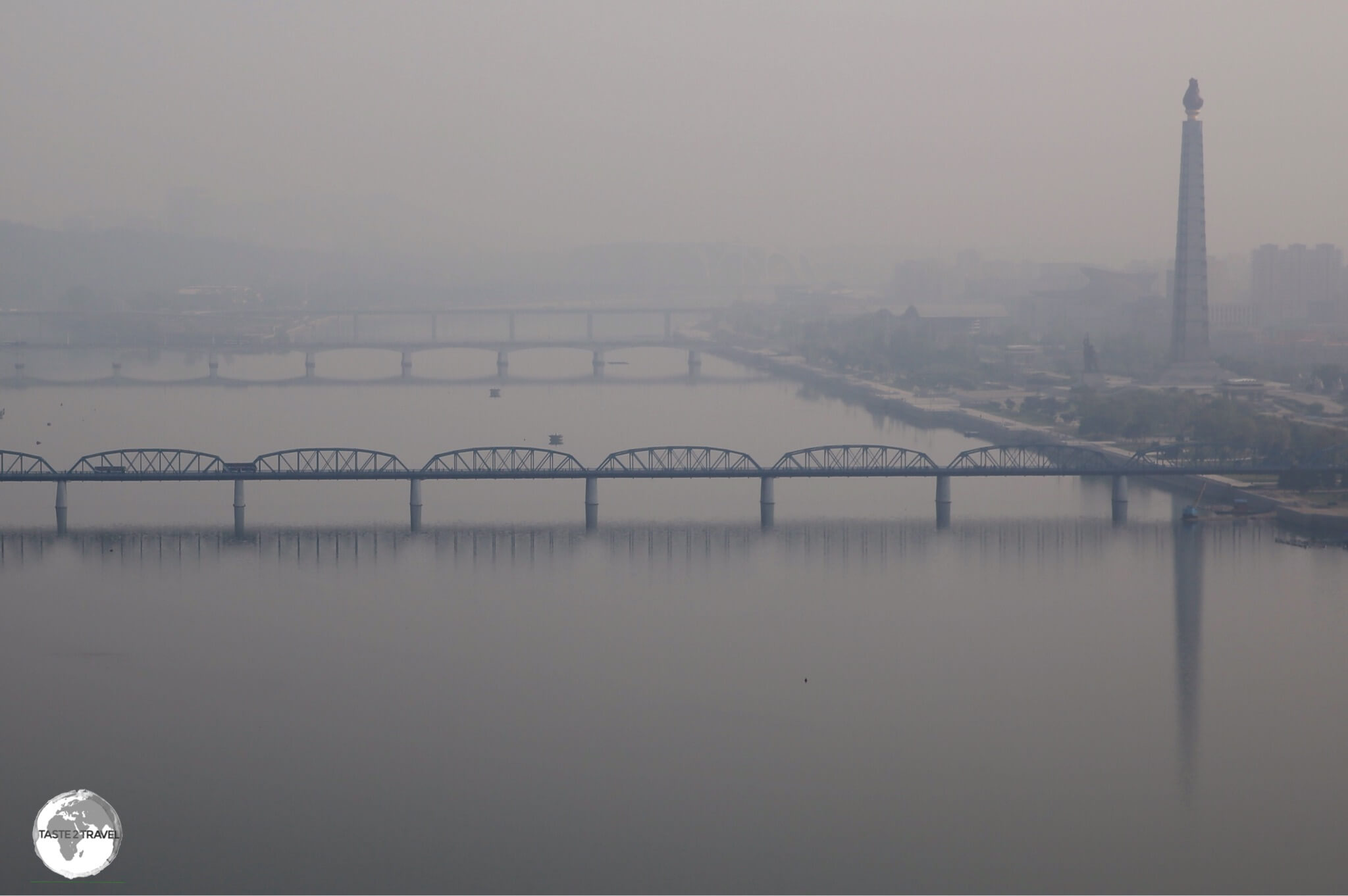
An early morning view, from my hotel room, of the Taedong River in Pyongyang, with the Juche Tower standing sentinel on the right bank.
Each of the eight days was exhausting, with early morning starts and late evening returns. This was no tour for slouches! The tour started in Pyongyang which is an incredibly clean, ordered, pleasant, un-rushed, city of 3-million inhabitants, who live in colourful apartment blocks.

A view of downtown Pyongyang and the Taedong River from my hotel room at the Yanggakdo International Hotel.
There’s no denying that the capital is a big show piece with grand, imposing buildings in the communist style and the tour company ensures you visit as many of these sights as possible.
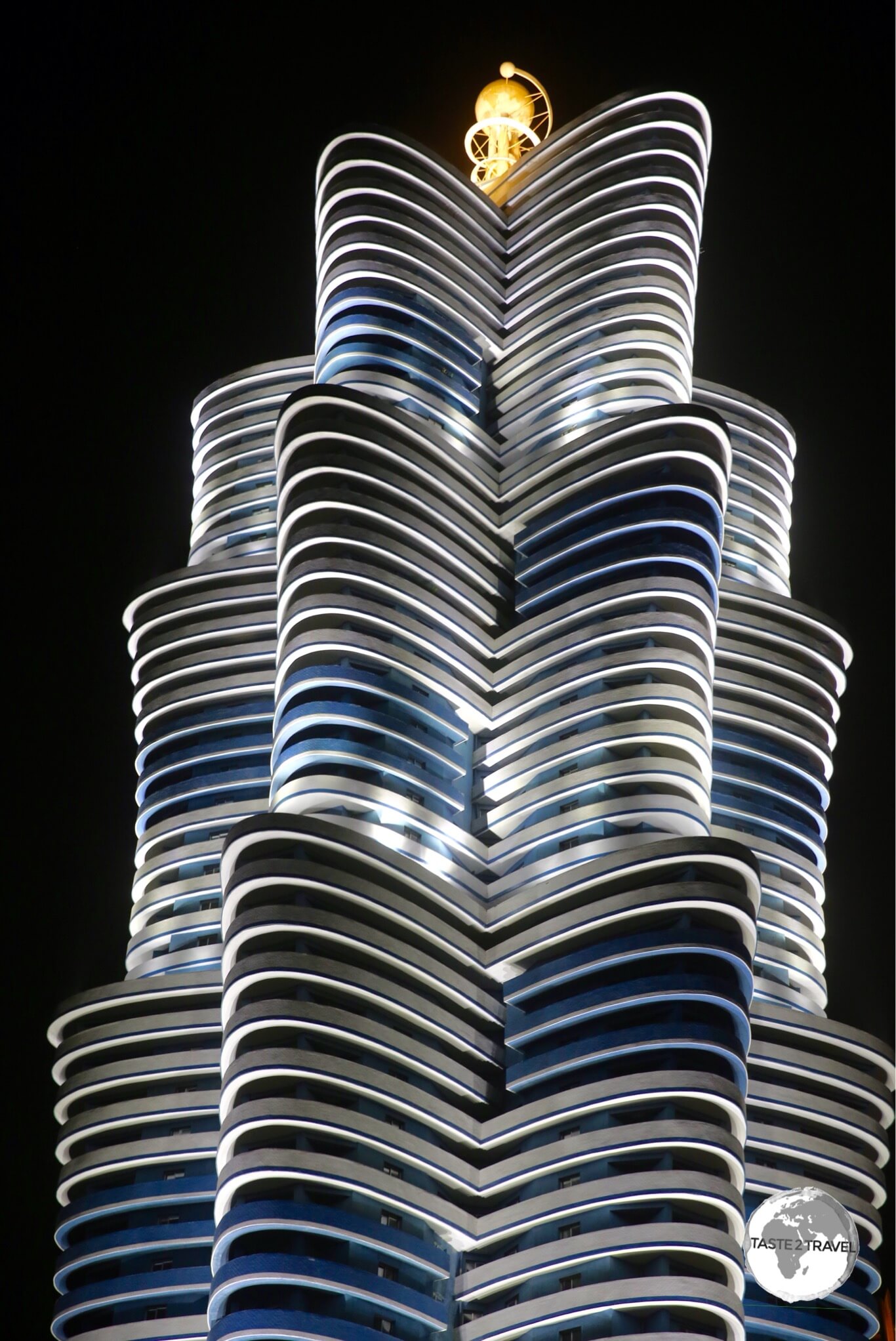
The tallest skyscraper on Pyongyang’s landmark Mirae Future Scientists street.
Most evenings, we drove down the show-piece Mirae Future Scientists street which is lined with recently completed apartment towers, one of which is 53 levels and was completed in just one year under orders from Kim Jong-un. The tower was opened by the leader on time, but apparently was incomplete and remained empty at the time of our visit.
Video:
Crossing the Taedong river in Pyongyang as seen from our tour bus with commentary provided by our KITC guide.
Due to the absence of cars in the country, the streets of Pyongyang are very quiet, giving the city a relaxed (clean) air. Ample green spaces and the mighty Taedong river (which bisects the city) add to the relaxed ambience.
Kim Il-sung square

A cyclist passes in front of images of the former leaders, Kim Il-Sung and Kim Jong-Il which overlook Kim Il-Sung square.
Kim Il-sung square is the main square of Pyongyang and the place where everything happens, including the big military parades.

The impressive edifice of the State Central Historical museum overlooks Kim Il-sung square in Pyongyang.
Located in the central district of Pyongyang, and named after the country’s founding leader, Kim Il-sung, the square was constructed in 1954 according to a master plan for reconstructing the capital after the destruction of the Korean War.

Named after the country’s founding leader, Kim Il-sung square is the main square in Pyongyang and the venue for the annual military parades.
The square is located at the foot of Namsan Hill, alongside the west bank of the Taedong River, directly opposite the Juche Tower, which lies on the opposite side of the river.

A cyclist on Kim Il-sung square, passing in front of Juche tower.
Foreign Language Bookshop

Hand-painted propaganda posters at the Foreign Language bookstore in downtown Pyongyang.
Located a short walk from the square, this bookshop stocks a range of books about DPRK. If you every wanted to learn more about Juche or the history of the country then you’ll find your reading material here.

Colourful DPRK propaganda postcards, on sale at the Foreign Language Bookshop in Pyongyang.
Books on the DPRK are published in many different languages. The highlight is the selection of hand-painted propaganda posters, which you can purchase.
Juche Tower

Located in downtown Pyongyang, the 170-metre Juche Tower is the world’s tallest stone tower.
Located on the east bank of the Taedong river, directly opposite Kim Il-sung square, Juche Tower is the world’s tallest stone tower, soaring 170 metres above the river.

A view of the colourful apartment blocks of Pyongyang from the top of the Juche tower.
Built from granite blocks in 1995 to celebrate the 50th anniversary of the founding of the Worker’s Party, the tower represents the eternally burning Korean Juche Ideology.
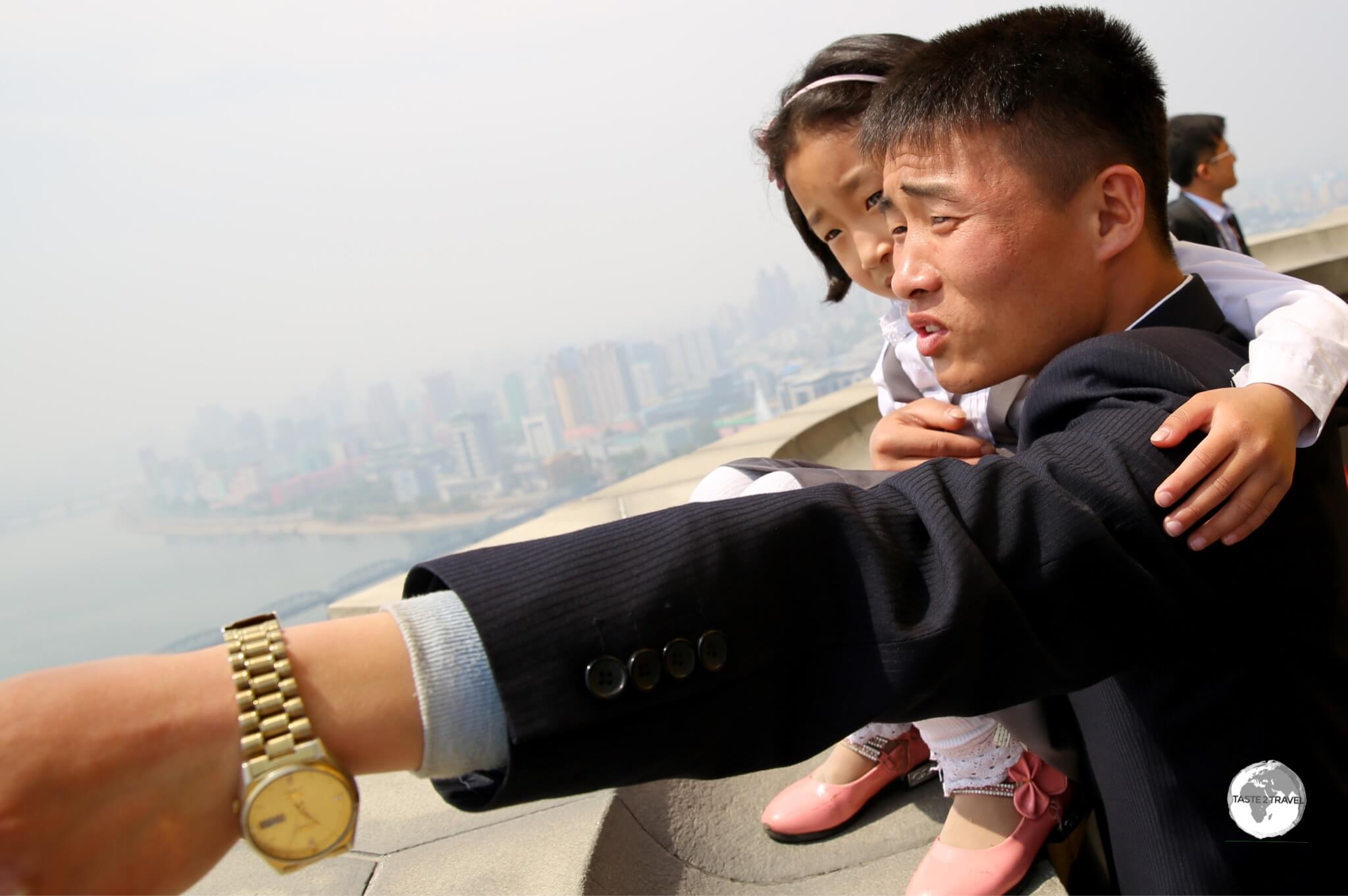
A North Korean family enjoying the panoramic views of Pyongyang from the top of the Juche Tower.
You can pay 5 Euros to take an elevator to the top of the tower from where you have spectacular outdoor panoramic views of Pyongyang. When we visited there was a local family enjoying the views.

Young girls enjoying the views of Pyongyang from the top of the Juche Tower.
Monument to Party Founding
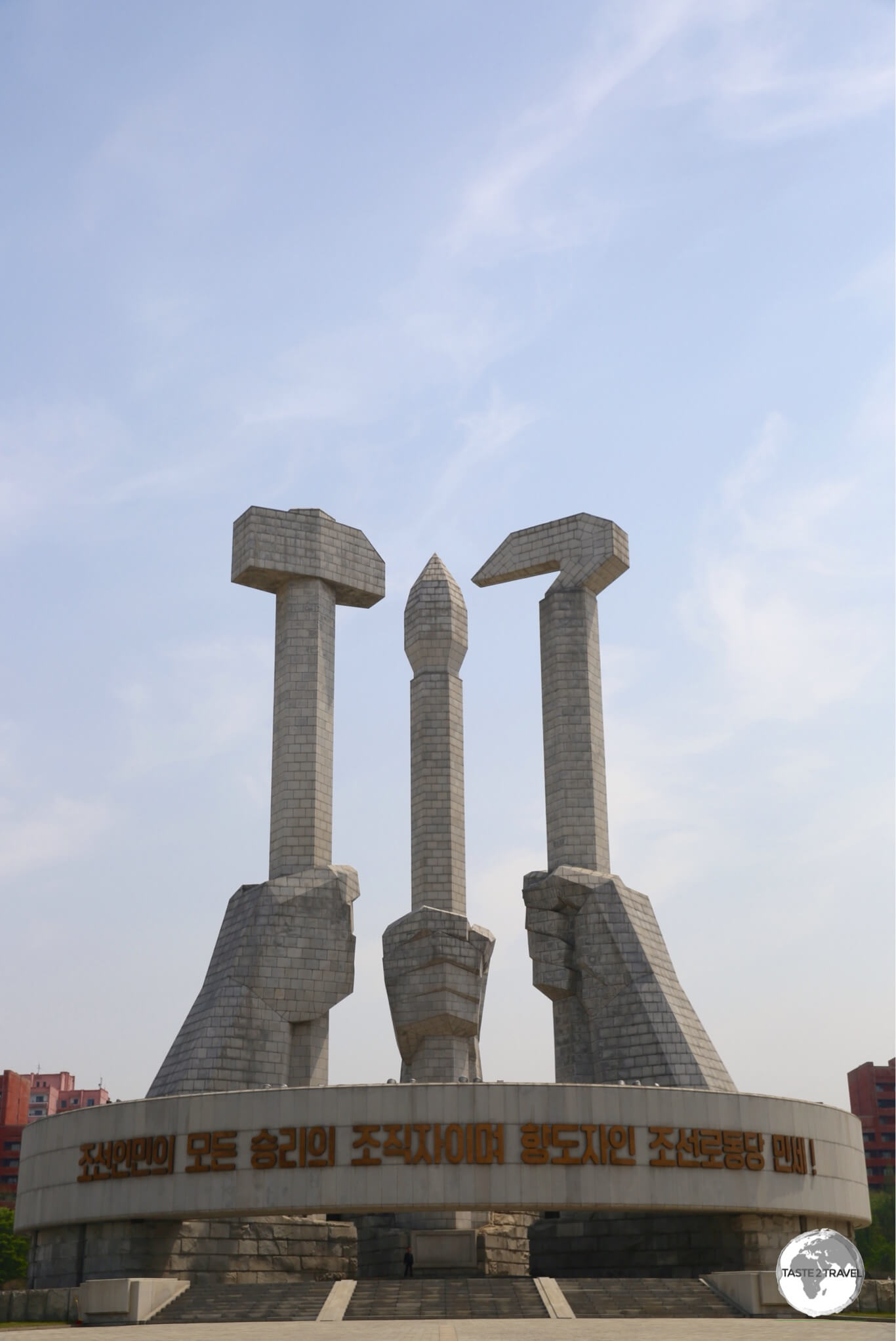
The Monument to Party Founding in Pyongyang.
Located a short distance from the Juche Tower, the Monument to Party Founding was built to symbolise the 50-year anniversary of the founding of the Workers’ Party of Korea.
The monument is rich in symbolism: the hammer, sickle and calligraphy brush symbolise the workers, farmers and intellectuals.

Detail of one of the large bronze panels which surround the Monument to Party Founding in Pyongyang.
The element is 50 metres high to symbolise the 50-year anniversary of the founding of the Workers’ Party of Korea. The number of slabs comprising the belt around the monument and its diameter stand for the date of birth of Kim Jong-il.

An old man relaxing at the Monument to Party Founding in Pyongyang.
Victorious Fatherland Liberation War Museum

Our military guide at the Victorious Fatherland Liberation War Museum in Pyongyang.
The Victorious Fatherland Liberation War Museum is North Korea’s museum dedicated to the Korean War. We were assigned a military guide for our visit with the highlight being a visit to the museum’s prize exhibit – the captured USS Pueblo – the only US Naval Ship still held captive by another country.
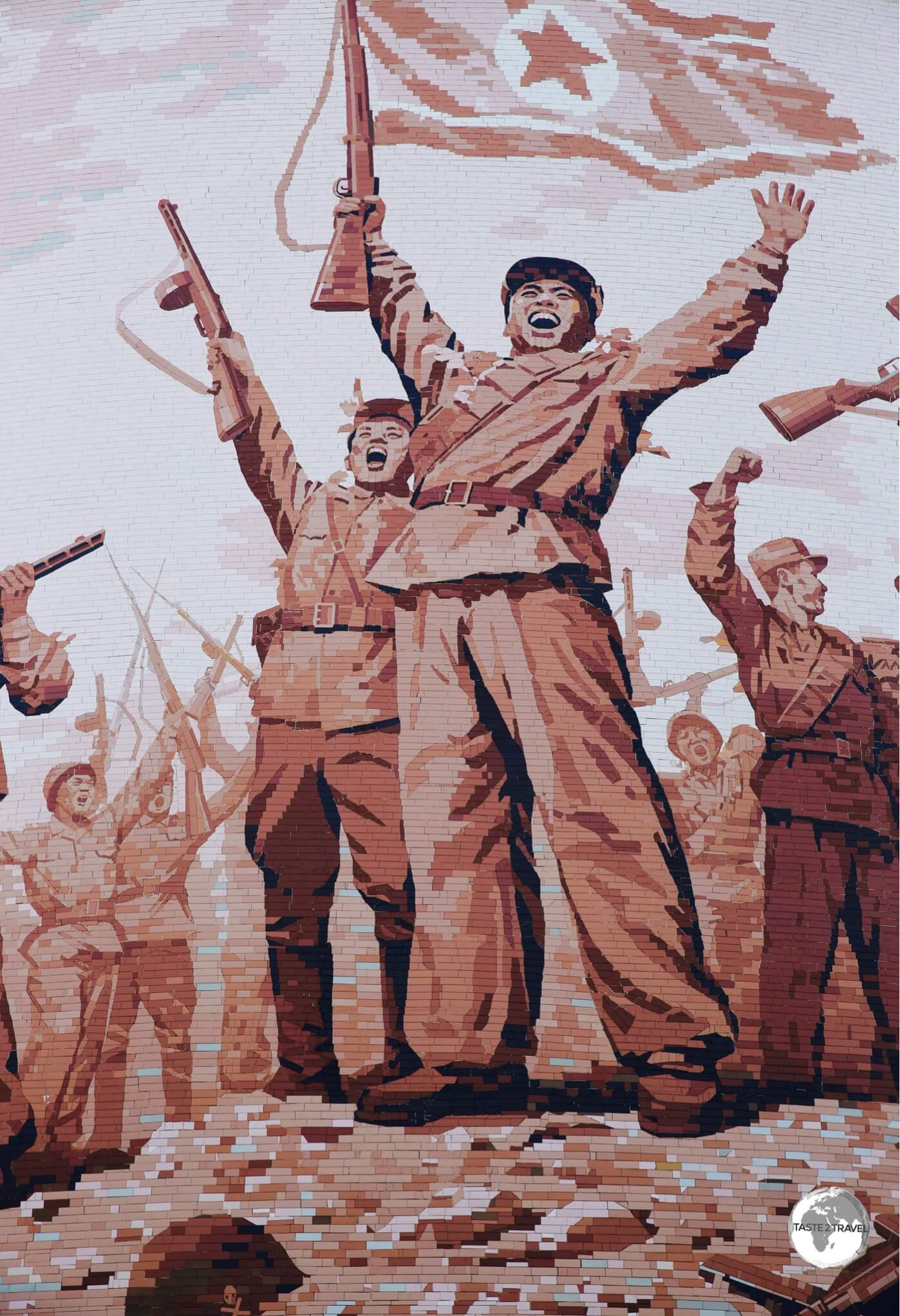
A giant tiled-mosaic depicting Victory at the Victorious Fatherland Liberation War Museum in Pyongyang.
This is a huge, sprawling museum, which covers everything from captured US weapons, to locally used weapons, to an amazing diorama (the Battle of Taejon) and so much more.
Mansudae Art Studio

The Mansudae Art Studios in Pyongyang are home to the only equestrian statue of the two former leaders in North Korea.
As you travel around North Korea, you can not help but be impressed by the monumental statues and works of art that adorn every corner of the country.

One of the resident artists at the Mansudae Art Studios in Pyongyang.
Many of these works are created at the vast Mansudae Art Studio in downtown Pyongyang. We had a studio guide assigned to us for a tour where we got to meet some of the resident artists and view new works being created.

A painting at Mansudae Art Studio, showing a wintry Mirae Future Scientists street in Pyongyang.
On the grounds of Mansudae Art Studio is an impressive statue of the two former leaders on horseback – the only one of its kind in North Korea.

A night time view of Mirae Future Scientists street, a showcase neighbourhood in Pyongyang.
Mangyongdae Schoolchildren’s Palace

A girls choir at Mangyongdae Schoolchildren’s Palace performs in front of a propaganda poster.
Kim Il-sung, the first leader of North Korea said “children are the kings of the country” and this remark is repeated throughout the DPRK.
The first schoolchildren’s palace in North Korea was opened in Kaesong, a city located near to the DMZ. Pyongyang has two schoolchildren’s palaces, the Pyongyang School Children’s Palace, located in central district, and the Mangyongdae School Children’s Palace.

Young girls performing at the Mangyongdae Schoolchildren’s Palace in Pyongyang.
This is the largest of the various schoolchildren’s palaces in North Korea. It is managed by the Korea Youth Corps and is dedicated to extra-curricular activities such as singing, dancing, music, handicrafts, computing skills etc.

Nothing like a North Korean rocket launch to enhance a children’s performance at the Mangyongdae Schoolchildren’s Palace in Pyongyang.
Every Tuesday and Thursday evening, the students of the school perform in the 2,000-seat theatre, with most tourists in the capital attending the shows.

Young performers at the Mangyongdae Schoolchildren’s Palace in Pyongyang.
It was all very perfect and you couldn’t help but think there is a lot of pressure on them to perform at the highest possible level.

Girls at the Mangyongdae Schoolchildren’s Palace in Pyongyang, performing a choreographed flight routine in front of a screen displaying North Korean fighter jets.
Korean Film Studio

Touring the Korean Film Studio with our KITC guide (right) and a studio guide.
The Korean Film Studio is located in Hyongjesan district in Pyongyang, which is about 16km outside of the city centre. Founded in 1947, the studio has produced hundreds of films over the years, including several which have won prizes in international film festivals. The studio is the principal producer of films in North Korea.

The Japanese film set at the Korea Film Studios.
While at the studio, we had the chance to visit the various sets (Seoul, China, Japan and Europe) and some of the group dressed up in costumes for photos.
Pyongyang Metro

At a depth of 110 metres, the Pyongyang Metro is the deepest in the world, with extra long escalator rides allowing commuters enough time to sit and relax.
We were fortunate to be able to spend an hour riding to three selected stops on the Pyongyang Metro – Puhung, Yonggwang and Kaeson.
The metro stations were built in different phases, with a first series opening between 1969 and 1972, and later stations opening in 1987. Containing sixteen stops and two lines, the Pyongyang Metro is the deepest metro in the world, lying 110-metres below street level.

The headlight from a locomotive illuminates one of the bronze panels at Puhung station on the Pyongyang metro.
First constructed in the 1960’s, the stations have been built in a grand style, similar to the Moscow metro, with stops featuring elaborate murals, mosaics and sculptures alongside ornate pillars and chandeliers.

Riding the Pyongyang metro during the morning rush hour, in a carriage full North Korean commuters, who were polite, curious and always keen to offer their seats.
Riding the metro allows you to get up close to the North Koreans as they go about their daily commute. It’s a fascinating experience!

A train arrives at Puhung station on the Pyongyang metro, passing in front of a mosaic propaganda mural.
The Pyongyang metro is the cheapest in the world for locals to ride, making it accessible to the entire population. It costs just 5 Korean Won (approximately 0.05 USD) with students receiving free tickets.

One of the key stations on the Pyongyang metro, Puhung station features a mural entitled The Great Leader Kim Il-Sung Among Workers.
The mural of Kim Il-sung at Puhung Station shows the eternal president and loyal workers during the reconstruction of Pyongyang after the Korean war.

A boy waiting for his train at Yonggwang metro station.
Yonggwang (Glory) station, one of the most palatial stations on the network, opened in April 1987. Its chandeliers are designed to recall the fireworks of victory celebrations, while the huge marble columns are sculpted in the shape of victorious flaming torches.

Ornate blown-glass chandeliers line the platform of Yonggwang station on the Pyongyang metro.
Yonggwang station features elaborate mosaics on either side of the platform which depict Pyongyang as seen from the Taedong River.

Metro guard on Yonggwang metro station. The walls of the platform are adorned with 80-metre-long mosaics depicting the Taedong river, which flows through Pyongyang.
Like metro systems in other former-socialist metropolises, such as Moscow, the stations on the Pyongyang metro are ornate works of art, full of impressive mosaics and statues of the dear leader, Kim Il-sung.

A Pyongyang metro guard, standing at attention, on a departing train at Yonggwang metro station.
Kaeson station, which translates as Triumph, features a bronze statue of Kim Il-sung giving his 1945 speech upon returning to Korea from Manchuria.

Kaeson station features a bronze statue of Kim Il-sung giving his 1945 speech upon returning to Korea from Manchuria.
Elsewhere in the station, there are portraits of the leader giving a speech “after he liberated the country through the arduous and bloody anti-Japanese war and returned home in triumph” as explained by our KITC guide.
The North Koreans are incredibly curious, friendly and polite and were always eager to give up their seats for us. Such interactions were a welcome change from the usual ‘rigidness’ of the tour.

The platforms at Puhung station are adorned with 80 metre long tiled mosaics.
The Arch of Triumph

The Arch of Triumph in Pyongyang, which our Korean guide was proud to tell us, is taller than the one in Paris.
From the last stop on our Pyongyang metro tour, Kaeson station, we surfaced next to the 60-metre high Arch of Triumph, the 2nd tallest in the world. Our guide was happy to point out the local Arch is taller than the one in Paris – and was built in just one year (like so many other monuments in DPRK).
The Arch of Triumph is a vast structure, its imposing nature only enhanced by the relative isolation in which it sits, alone on an expansive square surrounded by roads that see little traffic.
The arch was built to celebrate the victory over the Japanese and the return of General Kim Il-sung to his home city.
Pyongyang Circus

Acrobats perform at the Pyongyang circus
Another highlight of the trip was being able to attend a performance of the Pyongyang Circus, for which tickets cost 20 Euros. Thankfully there are no animals in this show, just an amazing line-up of incredible acts by acrobats, a strongman, jugglers, clowns etc.
Kwanbok Department Store
The Kwanbok Department Store is Pyongyang’s largest department store and the one place where tourists can change their hard currency into North Korean Won and shop alongside the locals.
It was wonderful to be able to take a break from the touring and do something regular like shopping and eating in a food court alongside North Korean shoppers. The store includes a food court on the top floor and a hot dog and waffle stand on the ground floor plus a supermarket where you can stock up on cheap but good Soju.
You can view a Japanese news report on the store here.
Taesongsan Fun Fair

North Koreans enjoying a free roller coaster ride at Taesongsan Fun Fair.
Another trip highlight was our visit to the Taesongsan Fun Fair during the May day public holiday. During the holiday, North Koreans flock to Mt. Taesong for folk games, picnics, relaxing and fun.
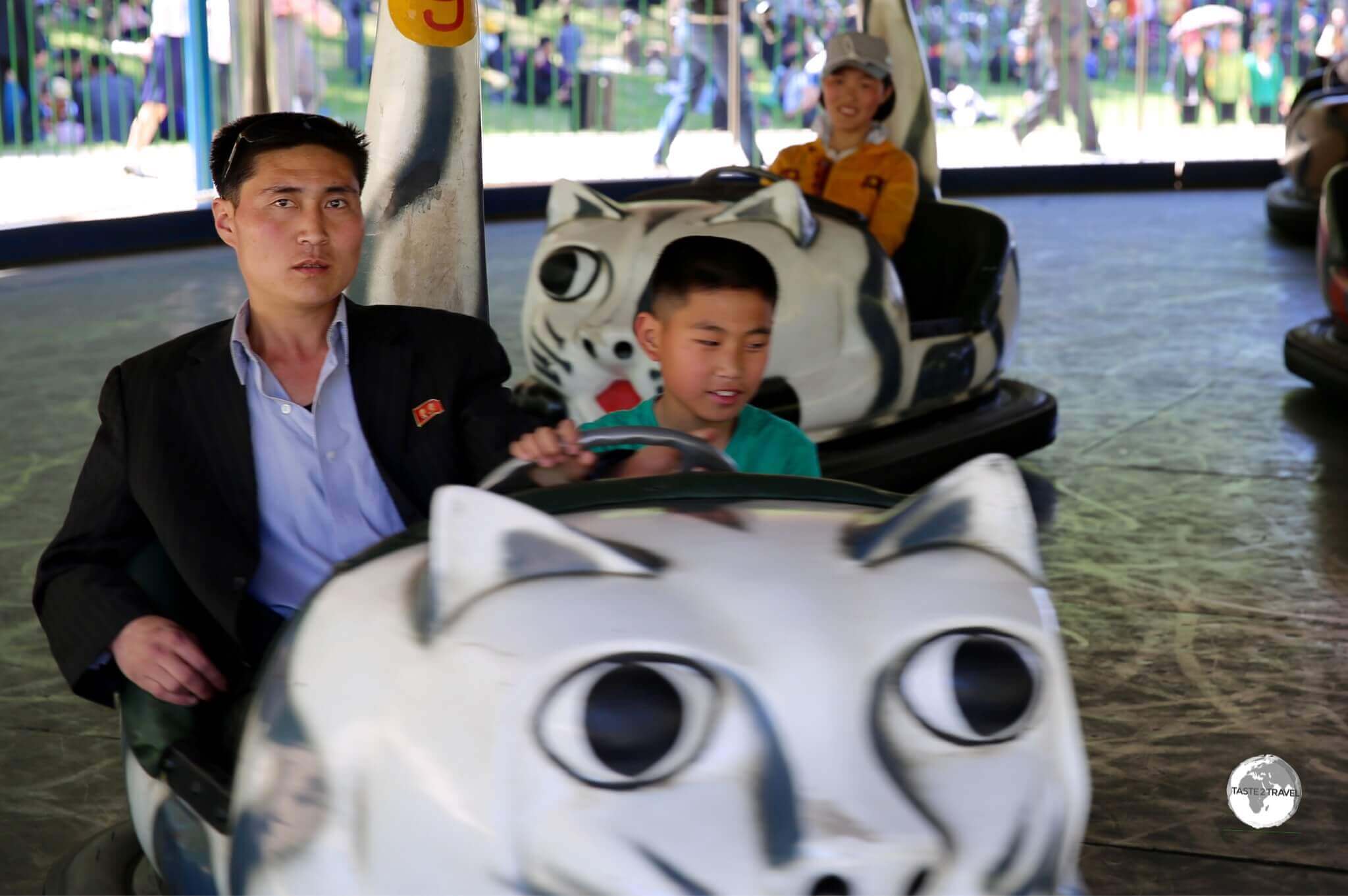
Father and son riding the bumper cars at Taesongsan Fun Fair in Pyongyang.
For the first time since entering North Korea, we were allowed to wander freely, without any guides or minders, and mingle with North Koreans who were enjoying the free rides and amusements at the park. In a country where the state provides everything, amusement rides are also free!

A family enjoying the splash boat ride at Taesongsan Fun Fair in Pyongyang
The Taesongsan Fun Fair is an amusement park located in at the foot of Mount Taesong, 12-km from Pyongyang. The park was opened in 1977 by Kim Il-sung and receives more than a million visitors each year.

A young school boy tries his luck at a shooting alley at Taesongsan Fun Fair in Pyongyang.
All rides at the park are free, with a priority line available for tourists should they wish to ride a North Korea roller-coaster. The park is huge and it was packed due to the holiday.

A father and son enjoying a roller coaster ride at Taesongsan Fun Fair on a busy May day public holiday.
There were 1000’s of locals enjoying the rides, picnicking, singing Karaoke, dancing and playing sports (football, volleyball, tug-of-war, sack races).
Pyongyang Central Zoo

The entrance to the Pyongyang Central zoo at Mt. Taedong.
The Korea Central Zoo, also referred to as the Pyongyang Central Zoo, is the national zoo of North Korea. It is located near Mt. Taesong in downtown Pyongyang.

A young girl playing at the Pyongyang Central zoo.
We visited the zoo during the May day public holiday, after our visit to the nearby Mount Taesong Amusement Park.
One of the more unusual exhibits is the ‘dog house’ which houses an impressive collection of dogs, including eight dogs raised by Kim Il-sung and given to the zoo after his death in 1994. A truly unique exhibit!

A father and son at the Pyongyang Central zoo.
All exhibits have a sign, in English, stating that the animal in the cage was kindly donated to the zoo by one of the leaders.

Young cadet girls enjoying their May day holiday at the Pyongyang Central zoo.
The zoo is home to over 5,000 wild animals, comprising a total of 650 species, and covers an area of roughly one square kilometre. It’s a popular place for North Koreans and a great place to see the locals relaxing in an informal, fun atmosphere.

North Koreans are always smartly dressed, even at the zoo.
Moran Hill

A group of friendly and welcoming North Koreans, enjoying a picnic lunch at Moran hill during the May day public holiday.
Located in central Pyongyang, Moranbong or Moran Hill, which translates as Peony hill, is clearly the venue of choice for Pyongyang families when they want to kick-back, relax, picnic, BBQ, dance, sing Karaoke and enjoy themselves.

Moran Hill is the place Pyongyang residents flock to during the May Day holiday to picnic, dance, sing Karaoke or spend time relaxing with their favourite companions.
We visited Moran hill during the May day holiday and were again allowed time to wander and mingle freely with the hordes of North Koreans who had come to the park to relax, picnic, sing karaoke, dance and drink ample Soju (rice wine).
Moran Hill was impossibly crowded on May Day but the North Koreans were out to relax and enjoy celebrating their holiday. They’re always keen to get tourists involved in their activities, whether it’s dancing, karaoke or joining in their picnic.
The North Koreans love to interact with tourists and were always insistent that we join in their drinking and celebrating.

North Koreans enjoy a May day holiday picnic on Moran Hill in Pyongyang.
It was on Moran Hill that I realised that the North Koreans definitely aren’t robots – just like anyone else, they are spontaneous and enjoy having fun.
There were sparks in the eyes of the people on Moran hill that day and it is something I’ll always remember. It was a wonderful moment and a great day to be in North Korea!
International Friendship Exhibition Hall
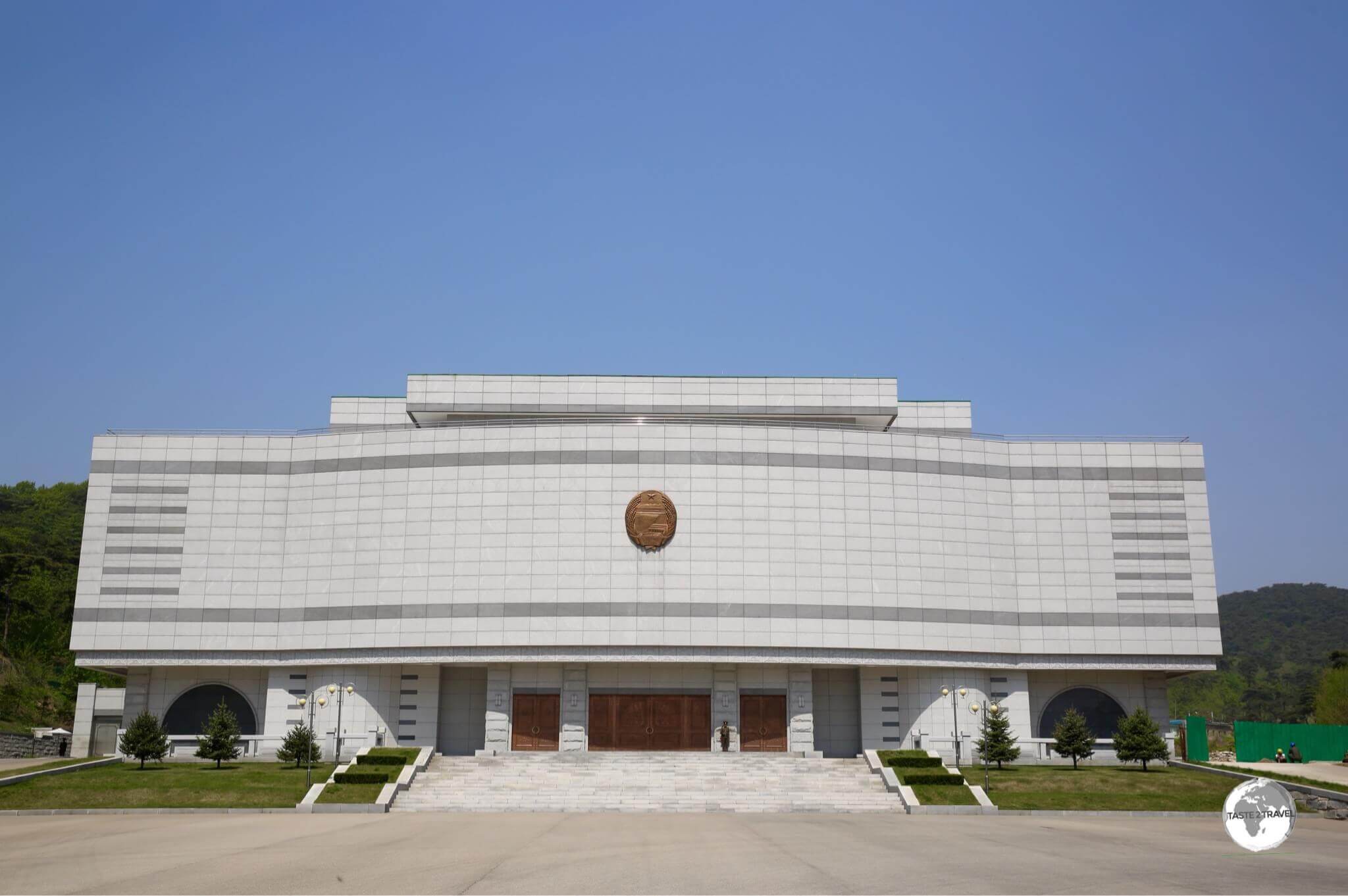
The International Friendship Exhibition Hall in Pyongyang.
The very austere looking International Friendship Exhibition Hall is home to a collection of halls that house gifts presented to former leaders Kim Il-sung and Kim Jong-il from various foreign dignitaries.
The museum is said to act as propaganda, giving the impression of worldwide support for the DPRK government. It’s one big display aimed at legitimising the regime.
The display halls are filled with works of art which span the spectrum from impressive/ incredible to cheap/ tacky. Absolutely no cameras or other recording devices are allowed inside the building.
We were free to take a photo of the exterior of the building but we were not free to turn around and take a photo of the country lane which leads to the exhibition hall. When asked why, our guide could provide no explanation but told us the guards will not allow it.
DPRK Science & Technology Complex

The DPRK Science and Technology complex in Pyongyang.
Opened in 2015, the DPRK Sci-Tech Complex is a science and technology centre housed in a large atom-shaped building which is located on the Ssuk islet in the Taedong River in Pyongyang. This massive showpiece was built in a year (of course!) by the The Korean People’s Army who were drafted in to speed up construction.

Users at the DPRK Sci-Tech Complex accessing the Kwangmyong, the North Korean version of the internet.
While internet access is blocked in North Korea, local visitors to the DPRK Sci-Tech Complex are able to use computer terminals to access the Kwangmyong (translates as ‘light‘), which is a North Korean (sanitised) intranet which provides access to a few government-controlled websites.

An idealised portrait of the DPRK leadership at the Science & Technology complex in Pyongyang.
The DPRK Sci-Tech Complex was not originally on our itinerary, but when we learnt that the centrepiece of the complex was a life-size replica of the rocket that launched North Korea’s first satellite, we all wanted to visit.

School girls explore a nature exhibit at the DPRK Science & Technology complex in Pyongyang.
The centre serves as a museum and educational facility as well as an e-library. During our visit, there was a school group in attendance who were enjoying the exhibits.

School girls exploring the interactive displays at the DPRK Sci-Tech Complex in Pyongyang.
While the complex houses scientific displays, it also includes interactive displays for children.

A school group at the DPRK Sci-Tech Complex in Pyongyang.
Like nearby projects such as Ryomyong Street and Mirae Scientists Street, the DPRK Sci-Tech Complex was designed in a modern semi-futuristic style.
Outside Pyongyang – Korean Demilitarised Zone (DMZ)

A propaganda billboard at the DMZ depicts a reunified North and South Korea. The Korea’s are often depicted as brother and sister in North Korean propaganda.
On a trip that was full of many amazing moments, our visit to the DMZ stands out as something truly special. Technically speaking, the Demilitarised Zone (DMZ) is a 4 km wide buffer zone that spans the border, running from coast to coast. The actual border is known as the Military Demarcation Line (MDL) and runs through the centre of the DMZ.
Understanding the DMZ

A map showing the DMZ slicing its way across the Korean peninsula.
Source: Smithsonianmag.com
In most places, the MDL is not accessible due to active minefields. We visited the Joint Security Area (JSA), also known as the “Truce Village”. The JSA is the only place where the two Korea’s are accessible.

A map of the Joint Security Area (JSA).
Source: lifeinkorea.com
The DMZ is a 2-hour (180 km) drive south of Pyongyang at the end of the (eerily quiet) Reunification highway.
On the outskirts of Pyongyang, we passed under the imposing granite Arch of Reunification, which was opened in 2001 to commemorate reunification proposals put forward by Kim Il-sung.
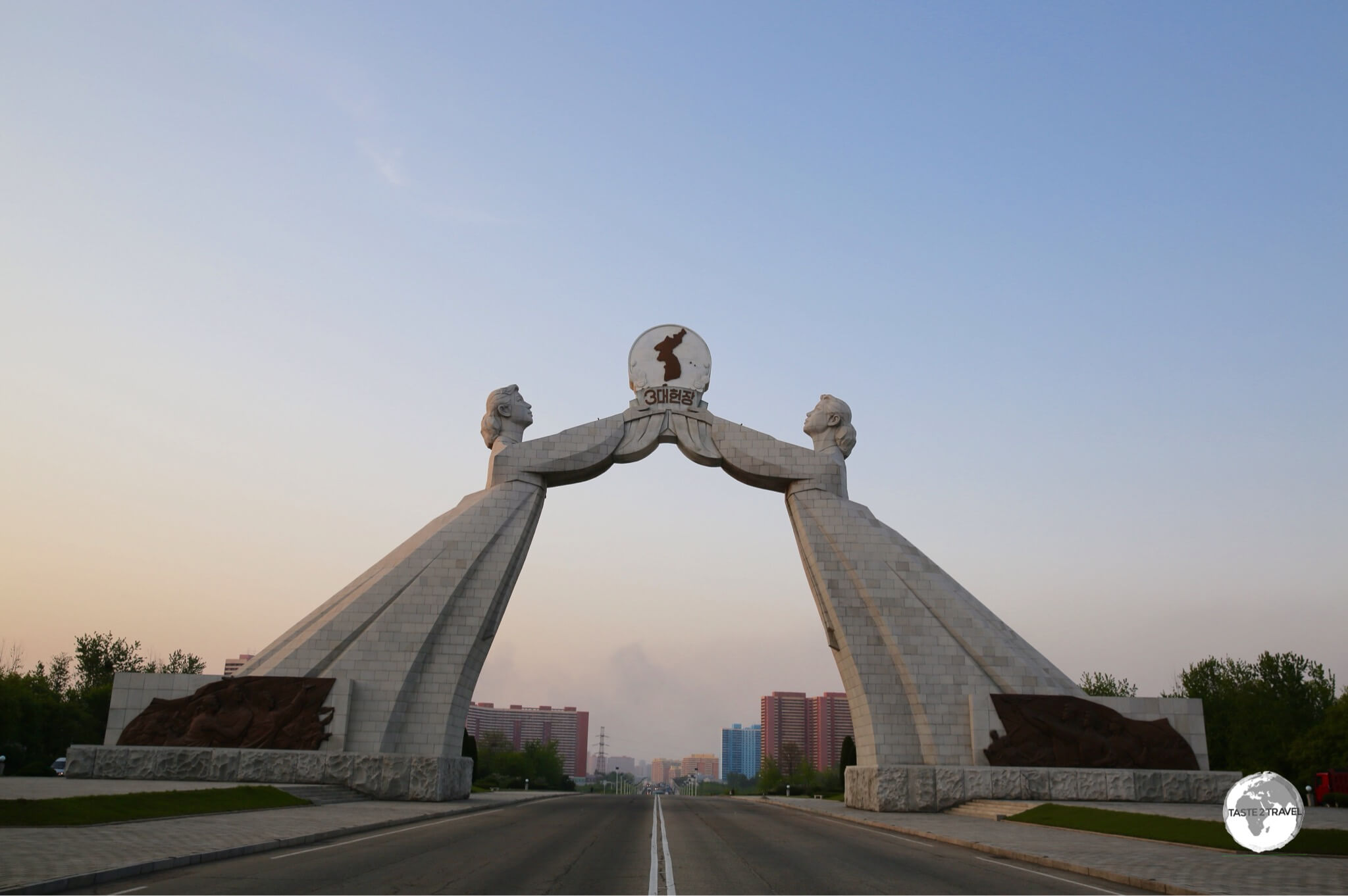
Located on the outskirts of Pyongyang, the Reunification Arch spans the Reunification highway which connects the capital with the DMZ.
At the halfway point, we stopped at a roadside service centre, the Sohung Rest House, which consisted of a few outdoor tables and chairs setup in a car park.

Service centre staff at the Sohung Rest House.
In this North Korean version of a service centre, there was a small kiosk selling tea, coffee and snacks and a few souvenir stands. This was purely a convenience for tourists with the only locals in attendance being the service centre staff.
As you get closer to the DMZ, military checkpoints begin to appear in rapid succession. Strictly no photography is allowed around the checkpoints. Ninety-nine percent of visitors to the DMZ visit from the South Korean side. Being able to visit from the North is something truly special.
Our bus parked at the main gate, on a sunken section of concrete road, which is where the DMZ access road cuts across the minefield which the North Koreans have installed along the length of the DMZ.
As the road is the only break in the minefield, it is lined with huge concrete blocks which are supported by wooden supports. In the event of an invasion, the wooden supports can be quickly removed, sending the concrete blocks crashing onto the road, blocking the only route across the minefield. Photography here is strictly prohibited!

Our military guide at the DMZ, providing an overview of the Joint Security Area.
At the main gate, we were led into a reception hall which is where we were assigned our guide – a young military officer. This was one DPRK soldier which we had permission to photograph.
After the guide explained the layout of the DMZ, we re-boarded our bus (along with our guide) and drove a short distance to the North Korea Peace Museum – the venue for the signing of the Armistice Agreement on 27 July 1953.

A North Korean soldier conducting a tour of the DMZ with a group of Chinese tourists.
Next stop was the Joint Security Area (JSA) – where we were able to enter one of the huts which lie directly on the MDL. In the centre of the hut, is a table which sits on the border – this is used for any discussions between the two sides.

Guarded by two North Korean soldiers, the blue door is the exit to the South Korean side of the JSA.
A row of microphones on the table mark the MDL. Inside the hut, visitors are able to move freely between North and South Korea. Two North Korean soldiers guard the South Korean exit door, ensuring no one leaves through the wrong door.

This table sits directly on the border between North and South Korea, with the line of microphones marking the border. While in the room you are free to move around the table, from North to South Korea.
After visiting the hut, we visited Panmungak Pavilion, where we were led to a balcony from which we had a view of the JSA, including the opposing South Korean pavilion – Freedom house. From here we returned to the main gate, dropped off our DMZ guide and continued north to the city of Kaeson.

The concrete strip running between the huts marks the border between North and South Korea.
JSA – the movie!

JSA (Joint Security Area) movie poster.
JSA is one of the most popular and highest grossing movies in South Korea.
This moving story focuses on an investigation into the circumstances surrounding a fatal shooting incident within the DMZ and the friendship that develops between two soldiers – one from the North and one from the South.
Kaeson

The 6-lane, main street of Kaeson, which was completely free of traffic, as is typical in North Korea.
After touring the DMZ, we back-tracked to the southern city of Kaeson (pop: 200,000). While today the city serves as a provincial capital, it was once the capital of a united Korea, during the Koryo (from where the name Korea is derived) kingdom.
Video:
A view of Kaeson city from our North Korea tour bus with commentary provided by our KITC Guide.
The city is a short drive north of the DMZ and during the initial partitioning of the peninsula along the 38th parallel, Kaesong was on the southern side of the line (within South Korea).
However during the first days of the Korean war, North Korean forces captured the city. As part of the Korean Armistice Agreement, North Korea was handed control of the city.

Statues of Kim Il-sung and Kim Jong-il, which overlook the city of Kaeson.
Overlooking the city are two giant statues of the former leaders, Kim Il-sung and Kim Jong-il. Despite the statues being just 100 metres from our lunch restaurant our guide advised that we were not allowed to visit the statues. I snapped this photo from outside the restaurant.
Koryo Museum

The Koryo Museum in Kaeson.
During our time in Kaeson, we visited the Koryo Museum (Korea’s first university and now a museum of history and culture).

Detail of temple awning at the Koryo Museum in Kaeson.
The Museum covers the site of what was the Songgyungwan Academy, a centre of ancient learning and instruction during the Koryo Dynasty in the 11th century AD. Kaesong was at this point in time the capital of all Korea and consequentially, the museum reflects that legacy.

Garden at the Koryo Museum in Kaeson.
The museum is a UNESCO approved world heritage site. The facility is normally always visited as part of North Korea tours after the group has visited the DMZ. It provides a refreshing, historical alternative to sites more affiliated with the regime.

Detail of ceiling inside a pavilion at the Koryo Museum in Kaeson.
Following our museum visit, we dined at the Thongil Restaurant where we were able to try their signature Dog soup (see the ‘Eating out‘ section below for more on this experience).
Phyongsong
While in Pyongyang, we made a half day trip to Phyongsong, which is located 32 km northwest of the capital and is famous as a centre for scientific learning and education generally. During our half day trip to the town we visited a model school and food processing plant.
Kim Jong Suk Middle School Number 1

The principal showing us a ‘model’ of the model school – the Kim Jong Suk Middle School Number 1 in Phyongsong.
Named after Kim Il-sung’s first wife, we toured this school with the principal who showed us a “model” of the model school and introduced us to an English language class where we had an “impromptu” interaction with the students.

The spotlessly clean corridor inside the Kim Jong Suk Middle School Number 1 in Phyongsong.
We were free to interact with them, ask questions etc.

A maths lesson at the the Kim Jong Suk Middle School Number 1 in Phyongsong.
Paeksonri Foodstuffs factory
While in Pyhongsong, we toured the Paeksonri Foodstuffs factory, a factory which supposedly produces a wide variety of goods, however the production lines were idle at the time of our visit.
We were able to purchase food products from the factory shop.

A propaganda poster at the Paeksonri Foodstuffs factory in Pyhongsong.
Nampo

Colourful apartment buildings line one of the many avenues in the city of Nampo.
Located on the west coast of the DPRK, 50km southwest of Pyongyang is the major port city of Nampo (pop. 366,000). We visited the region for two days, staying overnight at the Ryonggang Spa Resort.

Rice paddy fields located outside of Nampo city.
Chongsan-ri Cooperative Farm

Vegetable gardens at the Chongsan-ri Cooperative Farm.
Located just 8-km south of Pyongyang, on the highway which connects the capital to Nampo, the Chongsan-ri Cooperative Farm is the most famous farm in North Korea and has been declared a model farm by the state.
The farm produces crops, vegetables, fruits, rice, corn and beans. We toured a number of green houses where vegetables were being grown.
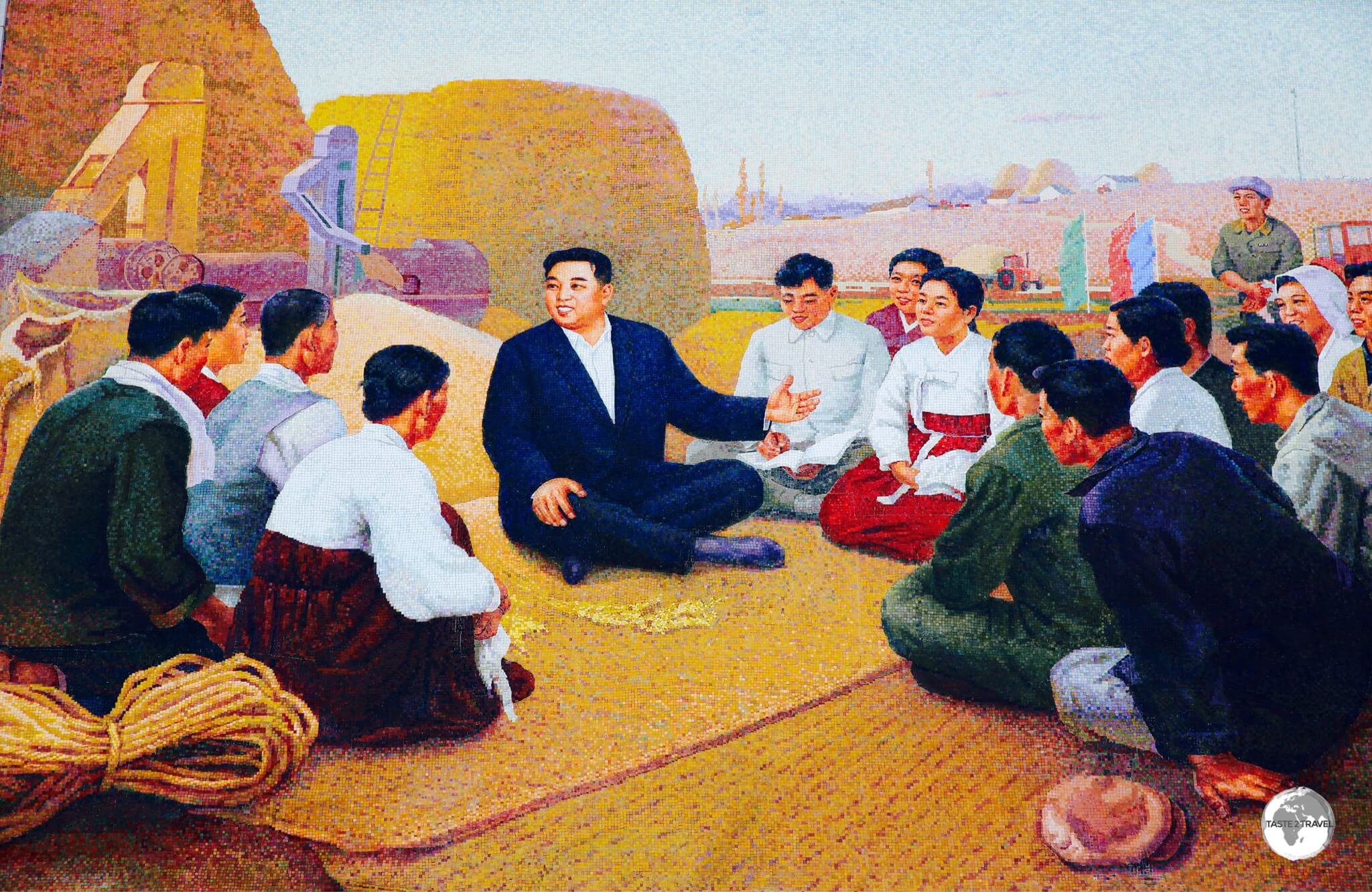
A tile mosaic at the Chongsan-ri Cooperative Farm commemorates the visit of Kim Il-sung to the farm in 1960.
The farm became famous in 1960 when Kim Il-sung spent 15 days on the farm and, supposedly developed agricultural techniques and delivered ‘direct advice’ to the farmers.
Often, when our guides mentioned that a leader visited a certain place, the reason for the visit was to give ‘direct advice’. The leaders are regarding by the people as being truly omnipotent.
Nampo Kangso Mineral Water Factory

Bottles of mineral water at the Nampo Kangso Mineral Water Factory.
Located a short drive from the Chongsan-ri Cooperative Farm, the Nampo Kangso Mineral Water Factory is considered North Korea’s treasured resource, the San Pellegrino of the DPRK.
Hundreds of metres beneath the factory are large aquifers of pure water that have been naturally carbonated by carbon dioxide (Co2) trapped deep underground. The factory bottles this naturally carbonated water and exports it to China.

The idle bottling plant at the Nampo Kangso Mineral Water Factory.
At the time of our visit the bottling line was idle but we were assured the plant had already met it’s daily quota of 30,000 bottles prior to our arrival. Of all the factories we visited in the DRPK, none of them were working during our visit.
We were able to photograph the idle production line and sample a bottle of water which could be described as the ‘San Pellegrino‘ of North Korea.
West Sea Barrage
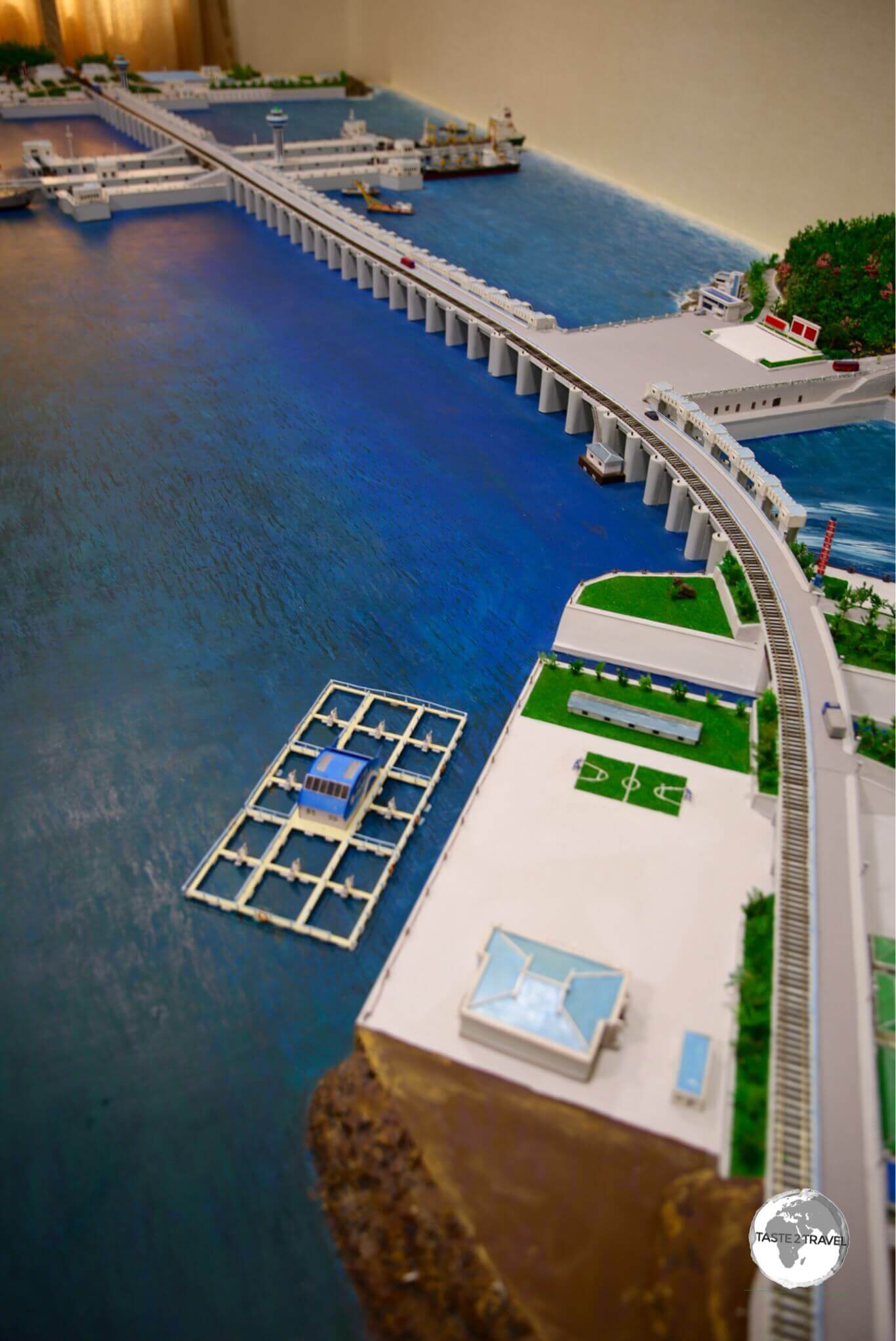
A model of the West Sea Barrage at the visitors centre.
Located 15-km from Nampo city, the massive West Sea Barrage was built to separate the Taedong River (which passes through Pyongyang) and the West Sea, thus protecting the inland from floods and ensuring the fresh river water is not contaminated by salt water.
The 8-km long barrage has effectively turned the river into a large lake, which provides a sustainable water supply for local agriculture. We visited the visitor centre, which is located on a nearby hill, where a guide showed us a model of the dam and then we watched a propaganda video on the ‘almighty effort‘ involved in the construction of the dam.
Sariwon

A cyclist in downtown Sariwon city.
On the return journey to Pyongyang from Nampo, we visited Sariwon city where we toured Sariwŏn Folklore Street. The street was constructed during Kim Jong-il’s reign with the aim of displaying an ideal picture of ancient Korea. It was one of the least interesting sights we visited during our 8 days.
You’re able to walk up to a small hilltop pagoda, which provides a panoramic view of the city. Tourists are kept in one small enclosed compound and are not allowed to walk around the busy, bustling town.
Accommodation
During our trip, we spent six nights in Pyongyang, where we stayed in two different hotels; the Yanggakdo International Hotel and the Sosan Hotel.
We also spent one night at the Ryonggang Spa Resort, which is located on the outskirts of the seaside city of Nampo.
While in North Korea, all hotel arrangements are made by the local tour company. Each evening you are delivered back to your hotel where you are required to remain until you’re collected the following day by the tour guide.
Pyongyang
Yanggakdo International Hotel

The Yanggakdo International Hotel is located on an island, in the middle of the Taedong river, in Pyongyang.
We stayed at three different properties, the most impressive was the Yanggakdo International hotel, which is located at the end of an island in the middle of the Taedong river in downtown Pyongyang.
The view out of my window on the 23rd floor was incredible. With more than 1,000 rooms, the hotel is the biggest in North Korea and has the best facilities by far.

The morning view of the Taedong river and Mirae Future Scientist street from the Yanggakdo International Hotel in Pyongyang.
On the 47th floor there is a revolving restaurant and bar. In the lobby there are more bars, restaurants, post office, mini-market, book shop, handicraft store and more. In the basement there’s a Karaoke lounge, ten-pin bowling lanes, swimming pool, ping-pong, gym, swimming pool, sauna and more. It’s surprising to see North Koreans (the privileged few) also enjoying these facilities. They are very competitive at bowling and ping-pong.
Breakfast was served each morning in a huge Barbie-pink dining hall, which featured an immense wood panelled scene of a typical North Korean forest setting on one of it’s walls.
Sosan Hotel
After returning to Pyongyang from Nampo, we stayed at the smaller (510 rooms) Sosan Hotel.
The hotel is located in the sports village which makes it a popular hotel for visiting sports teams (mainly African). Unlike the Yanggakdo, there are few facilities so evenings are quieter and more relaxed.
Breakfast each morning was pretty woeful, consisting of a selection of overly-processed Asian breakfast options.
Nampo

The wonderfully retro interior of the Ryonggang Spa Resort in Nampo.
For our one evening away from Pyongyang, we stayed at a wellness hotel, the Ryonggang Spa Resort, which is located 20-km northwest of Nampo.
Upon arrival, we were once again advised that we had to remain in the hotel complex, which (no doubt for our safety) is surrounded by a high concrete security wall with a guard posted at the main gate.
This wellness resort is set in a tranquil, natural setting with lots of trees, walking trails and a pond where some of the staff enjoy fishing. There’s a tennis court and night time activities include billiards, ping-pong and a video shooting game.

My chalet at the Ryonggang Spa Resort in Nampo.
The décor is so retro its kind of cool. The bathrooms contain a private mineral spa, which apparently supplies piping hot mineral water. I tried the spa but only ever got spurts of cold water.
The rooms are centrally heated, with the heating dialled up to ‘sauna hot’. I could not find any control button in the room to adjust the heat so I slept with the balcony door open.

The grounds at the Ryonggang Spa Resort in Nampo.
This fierce heating is supplied to every part of the room, including under the floor and in your bed (these are as hard as a marble slab). I left my bag on the floor overnight, by morning it was cooked. It was here that we got to try Petrol Clams (see the ‘Eating Out‘ section below for more on this).
Ryugyong Hotel

The 105-story Ryugyong Hotel dominates the skyline of Pyongyang.
While driving around Pyongyang it’s impossible to miss the towering Ryugyong Hotel. Looking more like a futuristic tower from a Star Wars movie, the Ryugyong hotel is cloaked in secrecy. We were never allowed near it, and our guide was reluctant to answer any questions regarding it.
When I asked our guide when the hotel was due to open, she smiled and replied “In time for your next visit“.
At 105-stories (330-metres), this pyramid-shaped glass skyscraper dominates the skyline of the capital. Construction commenced in 1987 and has been halted twice. At the time of my visit (May 2017) construction was still ongoing, which – in a country that’s obsessed with completing grand projects in just 12 month is certainly odd!
Eating Out

Farming in DPRK has hardly changed over the centuries, with most of it done manually.
Cuisine
From fried chicken to dog soup to petrol clams….
As with hotels, you have no say as to where you eat while in North Korea. Everything is organised in advance by your tour company – the Korean International Travel Company (KITC).
One day we had lunch at KITC Restaurant #1, another day we had dinner at KITC Restaurant #3. We always had plenty of food on the table – lots of fresh salads, ample meat, the ubiquitous kimchi and plenty of rice. Throughout the country you see people working by hand in the fields.

Rice seedlings being prepared for transplanting into nearby paddies outside of Nampo city.
All arable land is under cultivation and, because it’s done by hand, every little corner or land is farmed. There is very little machinery involved, save for the odd tractor, all of which were relics from a previous age.

Any mechanised farm equipment in North Korea is very antique.
One of the odd things about dining in North Korea is that after most meals the restaurant staff dim the lights, turn on the mirror ball, crank up the sound system and perform North Korean karaoke hits.
North Koreans love to sing and often have amazing voices. Our guide would occasionally sing Korean folks songs for us on the bus while on the way back to our hotel after dinner – she had a beautiful singing voice.
Breakfast each morning was served at the hotel. Lunch and dinner were always served in a pre-arranged restaurant. During our 8 days we were treated to many fine meals. The one thing lacking in North Korea is fresh fruit- occasionally we were served slices of apple for desert.

For lunch at the Thongil Restaurant in Kaeson, we were treated (?) to dog soup.
Culinary highlights included the opportunity to eat dog soup at the Thongil Restaurant (Reunification Restaurant) in Kaeson. The soup was spicy, which hid the real taste of the meat and distracted you from the fact that you were eating a puppy. Everyone ordered the soup but I believe no one finished it.
Petrol Clams

A highlight of our dinner at the Ryonggang Spa Resort were Petrol clams, seen here, arranged on the grill, prior to ignition.
Another culinary highlight was served at the Ryonggang Spa Resort in Nampo, where we were offered the chance to try Petrol Clams.

Our driver, Mr Lee, firing up the petrol clams, while our guide and minder look on from a safe distance.
What are Petrol Clams?
Clams cooked with petrol of course!
Why steam or bake when you can douse your clams in fuel and scorch them! It was a lot of fun and our driver of many talents – Mr Lee – was our chef extraordinaire.

As the sunset at the Ryonggang Spa Resort in Nampo, the shells of the petrol clams had become blackened and were almost ready to savour!
The clams were carefully laid out on a hot plate (with their mantles turned upwards so no petrol would seep in), then covered with petrol and ignited.
More and more petrol was added by the skilful Mr Lee, who seemed to enjoy this act of arson! Eventually, as darkness descended upon Nampo, the shells of the clams become blackened which we were assured was a sign that they were ready to enjoy!
As for the taste, once you got beyond the petrol soaked shell, the meat tasted interesting!
Bars

The craft beer selection at Taedonggang Brewery #3 in Pyongyang.
North Koreans love their beer and on two occasions we had the chance to sample local craft beers (all excellent) at two different microbreweries in Pyongyang; Taedonggang Brewery #3 and the Rakwon Microbrewery. Pints, which cost just 50 cents, included ales, pilsners, lagers and stouts.
While at the Yanggakdo Hotel, my nightly ritual included a pint of Yanggakdo Hotel Draught Beer (a very smooth, golden-blonde, ale) which was always served nice and chilled at the lobby bar. This was the perfect way to unwind after a long day of sightseeing.
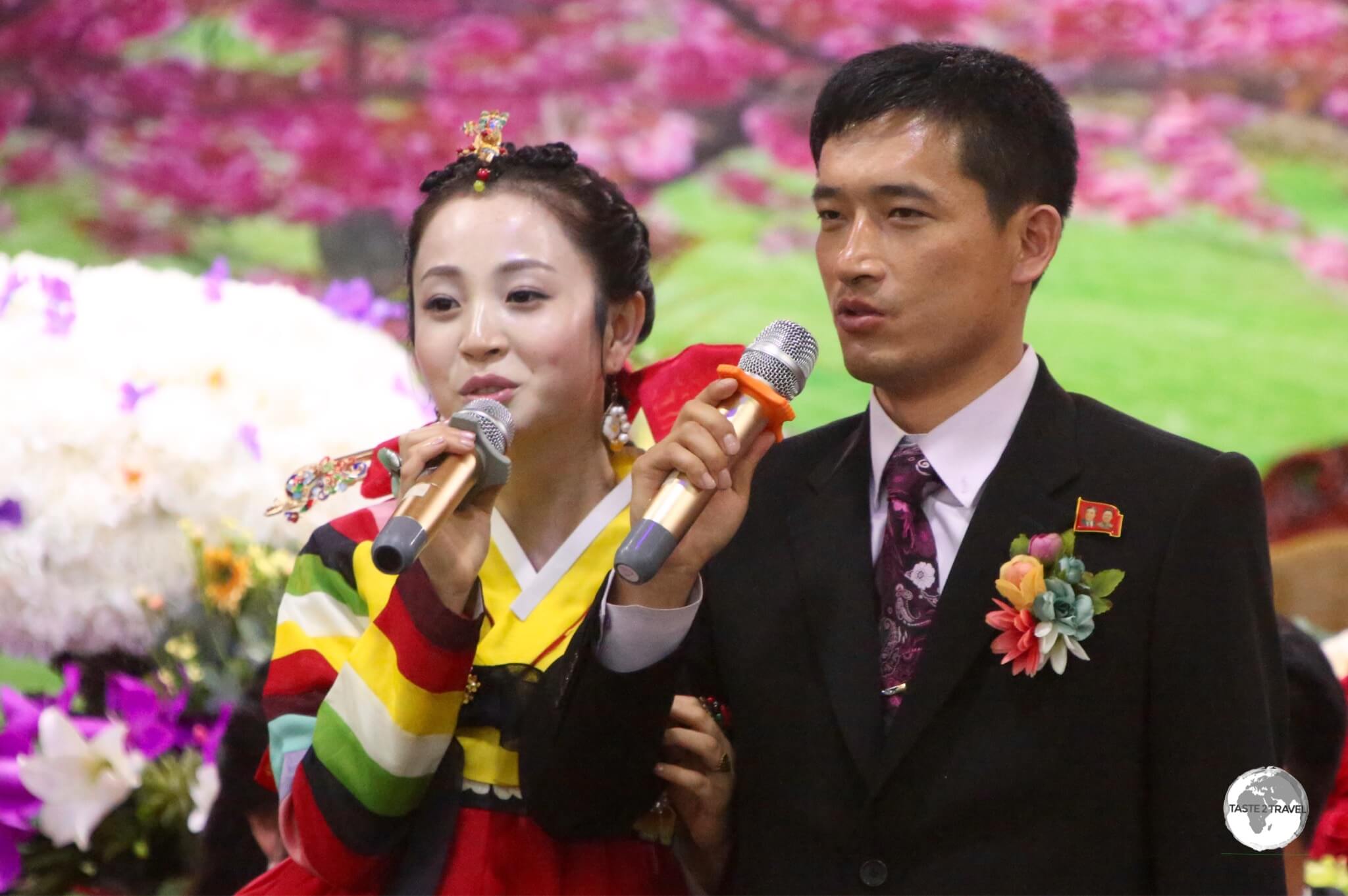
Newlyweds performing Karaoke at their wedding reception which was held in a private room at a bar in Pyongyang.
North Koreans love celebrating and will always encourage you to join in – whether it’s a wedding party, karaoke or dancing. The North Koreans are not shy!
Visa Requirements

My North Korean tourist visa, which was retained upon my exit from the country.
Everyone needs a visa to visit North Korea. If you apply at an embassy in a foreign country you will be issued with a visa in your passport and that visa will be stamped.
If you apply through a tour operator such as YPT, your visa will be issued on a loose-leaf sheet, which will be stamped and retained when you exit, leaving no evidence in your passport that you ever visited North Korea.
Getting There

Deep in thought – a North Korean passenger on the train from Sinuiju to Pyongyang,
By Air

Air Koryo is the airline of the DPRK.
International flights arrive at Pyongyang Sunan International Airport, which is located 24 kilometres from downtown Pyongyang.
It’s the hub for Air Koryo, the national airline of North Korea who, due to US and EU sanctions, maintains a fleet of ageing Russian Antonov aircraft and has the unfortunate distinction of being rated the worlds only one-star airline by Skytrax.
The following airlines offer flights to/ from Pyongyang:
- Air China – Flights to Beijing–Capital
- Air Koryo – Flights to Beijing–Capital, Shanghai–Pudong, Shenyang, Vladivostok
By Rail

The North Korean Railways train which transported us from Sinuiju to Pyongyang.
Rail transport in North Korea is provided by Korean State Railway which is the only rail operator in North Korea.
The country is covered by more than 6,000 km of track of which the vast majority is standard gauge; there is, however, nearly 400 km of narrow-gauge lines in various locations.

The lace-filled waiting room at Pyongyang railway station.
The one line which is used by tourists connects the border town of Sinuiju (located across the Yalu river from Dandong, China) to Pyongyang.

North Korean students waiting to depart on a local train at Pyongyang railway station.
Beijing to Pyongyang Train Schedule
- Train Number: K27 (In China)/ 51 (In North Korea)
- Departs: Beijing Railway Station every Monday, Wednesday, Thursday and Saturday at 17:27.
- Arrives: Pyongyang Railway Station at 18:15 the following day.
| Stations | Arrival | Departure |
|---|---|---|
| Beijing | — | 17:27 |
| Shenyang | 03:18 | 03:40 |
| Dandong | 07:22 | 10:00 |
| Sinuiju | 10:40 | 12:39 |
| Pyongyang | 18:15 | — |

A map of the rail journey from Beijing to Pyongyang.
Pyongyang to Beijing Train Schedule
- Train Number: K28 (In China)/ 52 (In North Korea)
- Departs: from Pyongyang Railway Station every Monday, Wednesday, Thursday and Saturday at 09:55.
- Arrives: Beijing Railway Station at 08:38 the following morning.
| Stations | Arrival | Departure |
|---|---|---|
| Pyongyang | — | 09:55 |
| Sinuiju | 15:02 | 16:43 |
| Dandong | 16:23 | 18:31 |
| Shenyang | 22:07 | 22:24 |
| Beijing | 08:38 | — |

The North Korean Railways sleeper train, which transported us from Pyongyang back to Dandong, China.
Getting Around
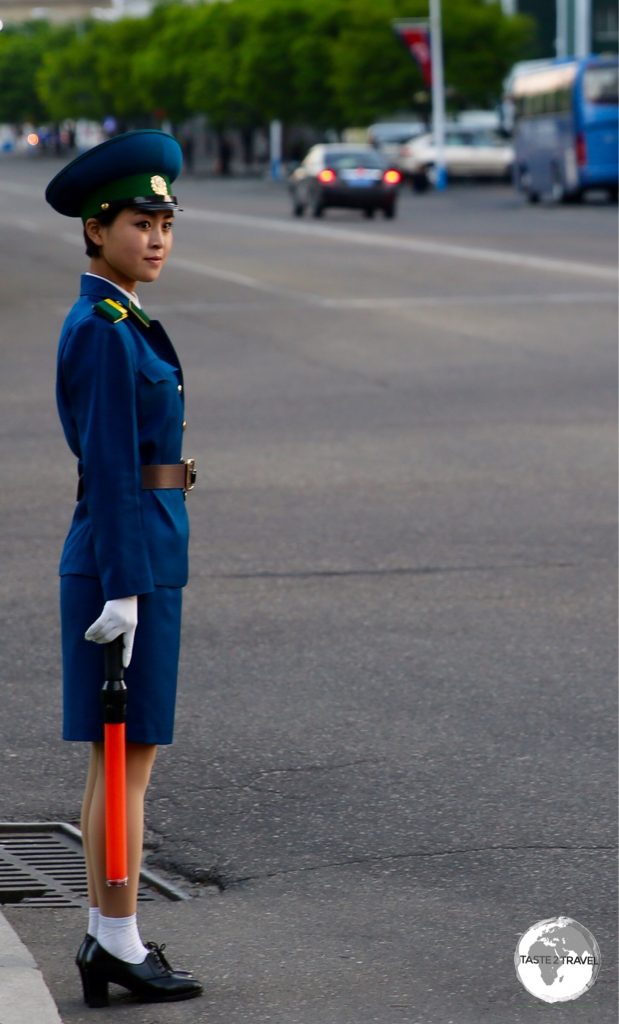
The traffic police officers in Pyongyang are always beautiful young girls.
Bus
As in any other country, there are public buses operating in North Korea but tourists don’t get to ride them. However, you will spend a lot of time on your private tour bus.
Taxi
There are some taxis operating in Pyongyang, but like the buses, tourists don’t get to use them.
Car

The wide, empty expressway connecting Pyongyang to Nampo is typical of roads in North Korea – completely free of traffic.
Forget about renting a car!
There is little private car ownership in North Korea, which means the streets are eerily quiet. Often we were travelling on empty 8-lane expressways (such as the one pictured above) when outside Pyongyang. It’s estimated that there are just 30,000 vehicles in this country of 25,000,000!
The few cars that do exist tend to belong to the military and government-run companies. There is an automotive industry, with Pyeonghwa Motors (Korean for peace), in the city of Nampo, producing 1,600 vehicles a year.

A North Korean car produced by Pyeonghwa Motors in Nampo.
That’s the end of my North Korea travel guide. I look forward to hearing from anyone who manages to travel to this fascinating destination.
Safe Travels!
Darren
North Korea Travel Guide North Korea Travel Guide North Korea Travel Guide North Korea Travel Guide North Korea Travel Guide North Korea Travel Guide North Korea Travel Guide North Korea Travel Guide North Korea Travel Guide North Korea Travel Guide North Korea Travel Guide North Korea Travel Guide North Korea Travel Guide North Korea Travel Guide North Korea Travel Guide North Korea Travel Guide North Korea Travel Guide North Korea Travel Guide North Korea Travel Guide North Korea Travel Guide North Korea Travel Guide North Korea Travel Guide
North Korea Travel Guide North Korea Travel Guide North Korea Travel Guide North Korea Travel Guide North Korea Travel Guide
Author: Darren McLean
Darren McLean is an Australian, full-time, digital nomad who has spent 37 years on a slow meander around the globe, visiting all seven continents, 192/ 193 UN countries and 245/ 251 UN+ countries and territories.
He founded taste2travel to pique one’s curiosity and inspire wanderlust.

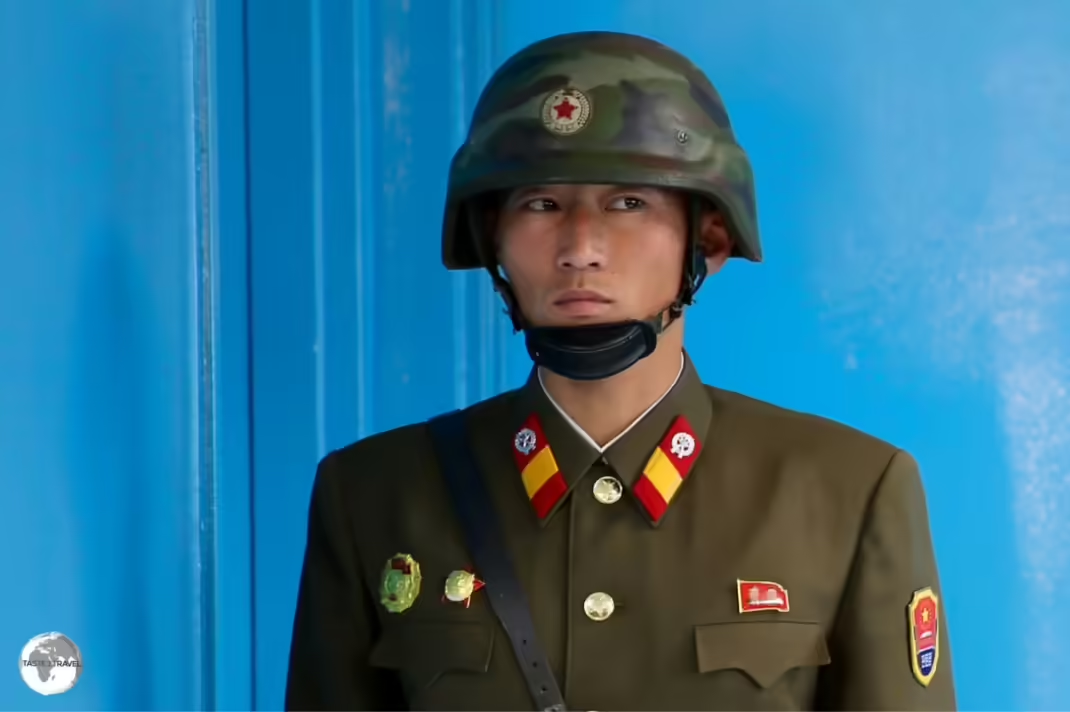
Loved this site,Very interesting and informative
Thanks Mum! Pleased you enjoyed the blog.
Hi Darren,
I am a freelance journalist writing a feature about western tourism to North Korea and I want to speak with people that have been.
Would you be happy to speak with me about your trip and how it matched your preconceptions?
Kind regards,
Stephen Jones
Email: spjonesjournalist@gmail.com
Hi Stephen,
Happy to talk to you regarding DPRK. I’ve contacted you via your email address.
Regards,
Darren
Enjoyed reading your blog. North Korea is a fascinating country.
Thanks Jack! Pleased you enjoyed the blog. ?
Thanks Darren – a really informative and useful read – well done!
I’m an Aussie considering going for May Day 2018.
Probably not YP – but of course the itinerary would be very much the same.
Hi Macca!
You’ll have an amazing experience. If you have any questions in the meantime please contact me.
Darren ?
I enjoyed your blog. Love your photos. I’m looking to visit DPRK later this year. Just wondering what camera(s) and lenses you took on this trip?
Hi Colin,
Pleased you enjoyed my DPRK report. I took a Canon EOS 5D Mark III with two lenses: 24-70mm (f/2.8) and 70-200mm (f/2.8).
All electronic equipment entering the country will be recorded on a manifest by DPRK customs. When you exit the country, the manifest can be checked (ours wasn’t). The aim of this exercise is to ensure no electronic equipment is left inside DPRK.
If you have any further questions on DPRK, please contact me.
Safe travels.
Darren
Further to the couple of previous comments – just above – one from me and also from Colin
I’m back now from my May Day trip and it was an eye opener. Great trip – loved it all – but what a crazy miserable place. Was at the DMZ a few days after the North/South meeting – so maybe something will come of this suggestion of peace and cooperation. Surely it cannot last indefinitely in this current state.
In terms of cameras etc – we got the 3rd degree going in i.e. had to open up all my bags and they checked camera, phone and even books and magazines I’d brought with me. (Earlier I’d even had to delete some photos while on the plane while on the way to NK). Hence I was pretty nervous about what it’d be like coming out – which I did via the train after the final night in Sinuiju. But they were very slack at that border crossing and didn’t examine anything in detail – looked at the phone but didn’t look at any contents. Thankfully the extra camera memory cards in my suitcase were not an issue at all!
BTW – my camera was a Sony RX10 Mk 3 which has a good 600mm zoom for getting close to the action.
So thanks again Darren – and good luck Colin
Hi Macca,
Please to hear your trip to DPRK was and eye opener. It is a unique travel destination, offering a totally different travel experience.
Great that you got to shoot with a 600mm zoom – please share some of your photos.
Thanks,
Darren
Hello. I happened to Google and read your article to the end. What an interesting and informative piece of information. I’m thinking of looking at it one by one from beginning to end. Thank you for the good information
Many thanks for your positive feedback Su.
Safe Travels!
Darren